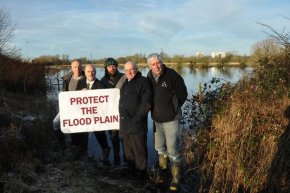Germany is currently experiencing heavy flooding in two western states; Eastern Belgium is also heavily affected.
Reason for the floods is heavy rainfall at levels exceeding any in the area in the last 100 years.
So far there have been 59 deaths in Germany and 20 in Belgium; in one German county alone 1,300 people are missing. About 10,000 people in Germany have been evacuated; Belgium is currently evacuating central Liege - a city with 200,000 people - and the Netherlands are evacuating 10,000 from Maastricht.
Along some smaller rivers virtually all bridges have been destroyed. Railway routes and highways between the Ruhr area and Brussels as well as to South Germany are interrupted. In multiple places dams have broken, leading to influx of water into usually dry areas - as an example the Inden strip mine has been flooded. In other places dams are expected to break tonight as water masses arrive from higher up.
South Germany is expecting storms with heavy rainfall this morning (even if i don't see a single cloud right now), which will push further water into the now flooded areas in the next 2-3 days.
Germany on thursday according to the Federal Ministry of the Interior deployed nearly 15,000 civil protection forces in the area, including 2,100 from the federal technical assistance corps and 850 military (mostly an engineer battalion stationed nearby). The Dutch Army is also deploying "several hundred" men. France, Austria and Italy have deployed units in support in Belgium, coordinated by the EU. In one town in Germany where isolated looting has been reported a police company has been deployed additionally.
Reason for the floods is heavy rainfall at levels exceeding any in the area in the last 100 years.
So far there have been 59 deaths in Germany and 20 in Belgium; in one German county alone 1,300 people are missing. About 10,000 people in Germany have been evacuated; Belgium is currently evacuating central Liege - a city with 200,000 people - and the Netherlands are evacuating 10,000 from Maastricht.
Along some smaller rivers virtually all bridges have been destroyed. Railway routes and highways between the Ruhr area and Brussels as well as to South Germany are interrupted. In multiple places dams have broken, leading to influx of water into usually dry areas - as an example the Inden strip mine has been flooded. In other places dams are expected to break tonight as water masses arrive from higher up.
South Germany is expecting storms with heavy rainfall this morning (even if i don't see a single cloud right now), which will push further water into the now flooded areas in the next 2-3 days.
Germany on thursday according to the Federal Ministry of the Interior deployed nearly 15,000 civil protection forces in the area, including 2,100 from the federal technical assistance corps and 850 military (mostly an engineer battalion stationed nearby). The Dutch Army is also deploying "several hundred" men. France, Austria and Italy have deployed units in support in Belgium, coordinated by the EU. In one town in Germany where isolated looting has been reported a police company has been deployed additionally.

